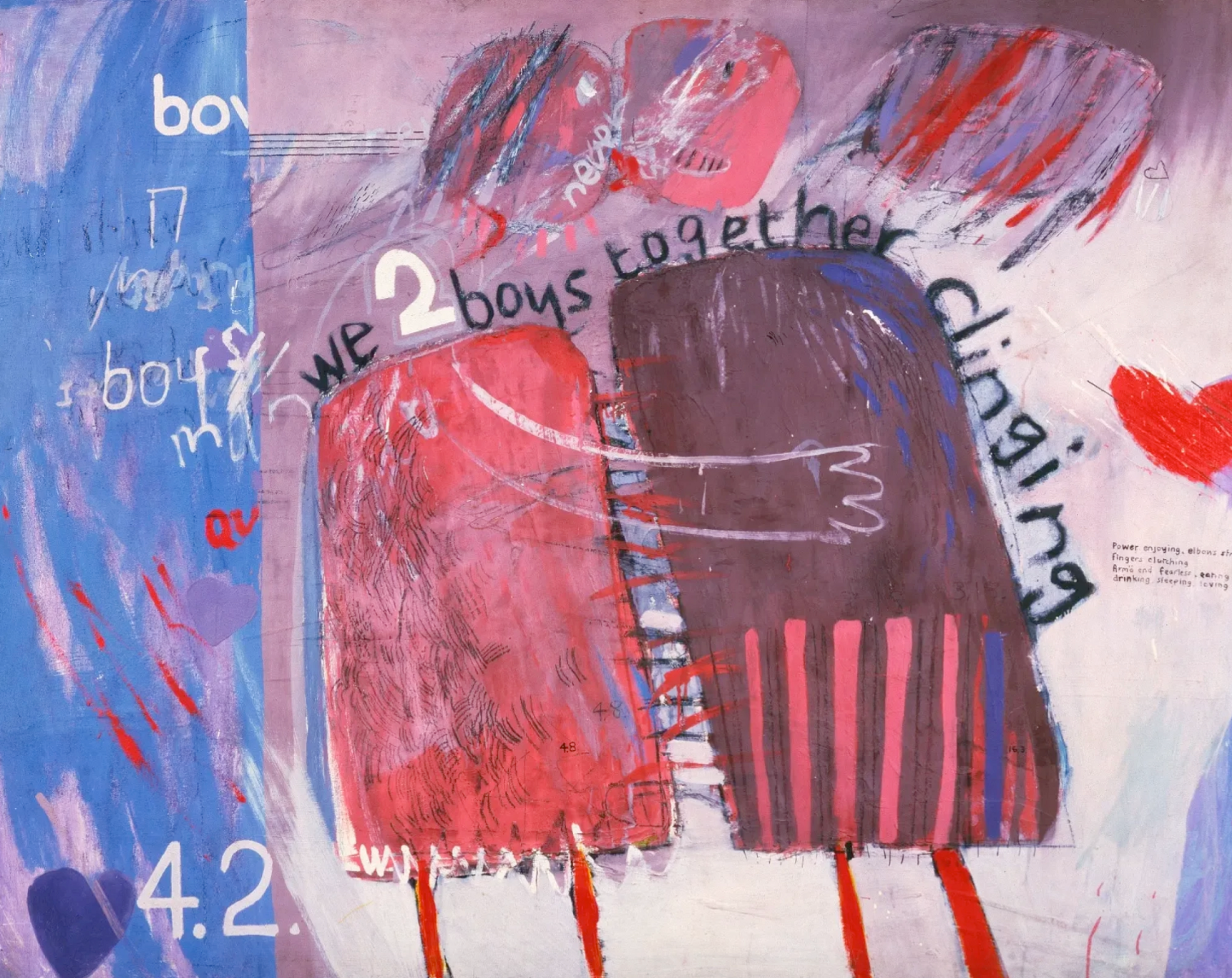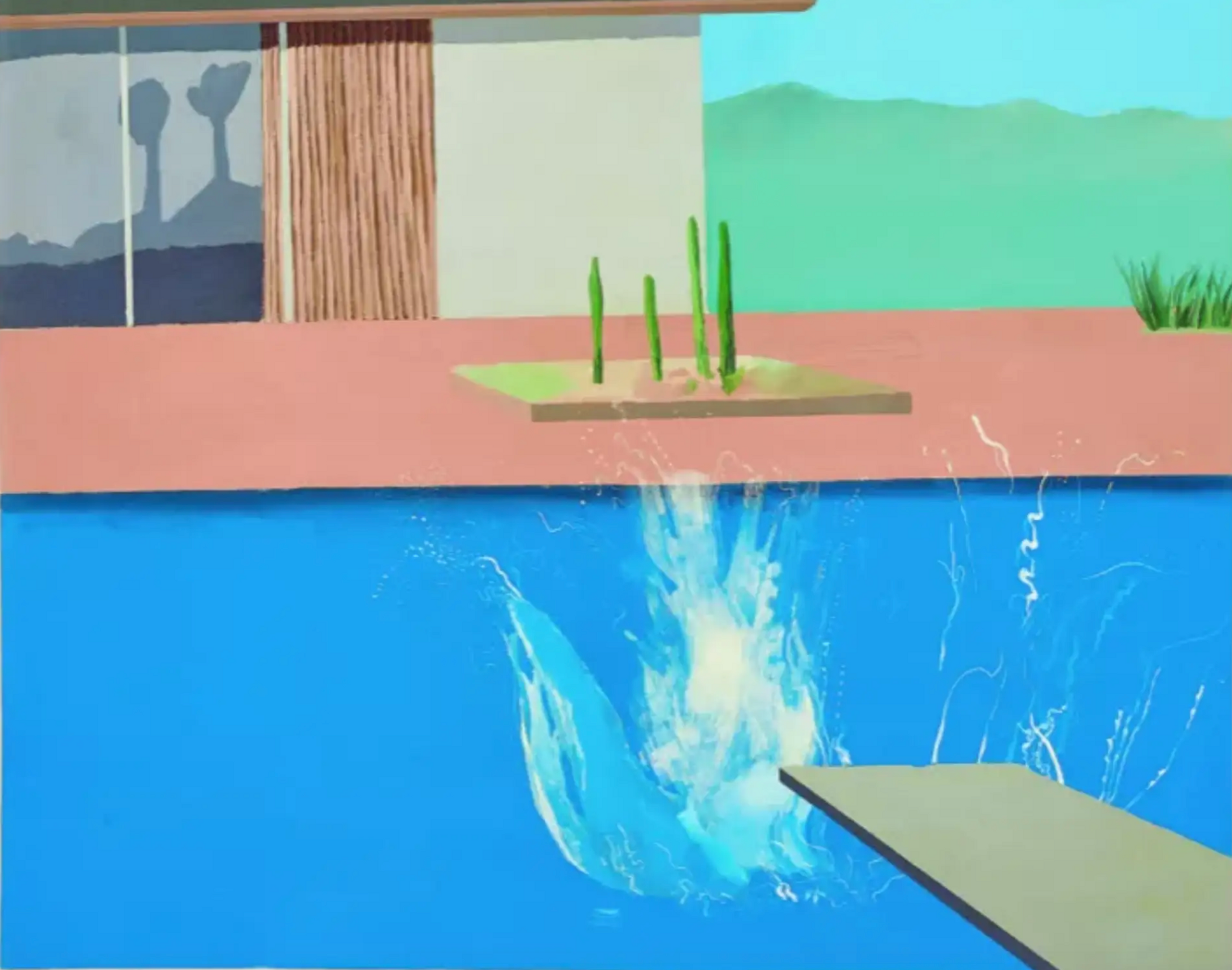 Image © Christies / Love, Sex and Desire © Andy Warhol 1950-1962
Image © Christies / Love, Sex and Desire © Andy Warhol 1950-1962
Interested in buying or selling
Andy Warhol?

Andy Warhol
487 works
Artist muses have had a profound influence on the likes of famous artists like David Hockney, Francis Bacon, Alex Katz, and Andy Warhol.
The genius of such artists is as much a product of those they met (and fell in love with) along with their own creative flair. In this article, we take a look at how some of the greatest artists of the 20th and 21st century have incorporated their lovers into their œuvre, using them as key inspirations for their paintings.
David Hockney: Peter Schlesinger and Gregory Evans
In the early 1960s, much loved British artist David Hockney — then still a student at London’s Royal College of Art — caused a storm with his cartoon-like ‘Love’ paintings. These graffiti-like works, which include the seminal We Two Boys Together Clinging (1961) and Cleaning Teeth, Early Evening (10pm) W11 (1963), made hushed, coded references to homosexuality at a time when it was still illegal in the UK.
 Homosexuality wasn't legalized until 6 years after Hockney depicted gay love in his series. (Image © Hayward Gallery / We Two Boys Together Clinging © David Hockney 1961)
Homosexuality wasn't legalized until 6 years after Hockney depicted gay love in his series. (Image © Hayward Gallery / We Two Boys Together Clinging © David Hockney 1961)In 1964, Hockney relocated from post-war London to California – a place characterised by searing sun, modernist architecture, and sexual liberation.
While teaching a summer drawing class at the University of California Los Angeles (UCLA), Hockney met the young Peter Schlesinger. Then a student and later a portrait artist, Schlesinger quickly became Hockney’s model; before long, Schlesinger was Hockney’s muse and lover.
Soon enough, Schlesinger moved into Hockney’s Los Angeles home and later accompanied him to London, where he enrolled at the world-famous Slade School of Fine Art.
The subject of a long line of etchings, the American artist has appeared in some of Hockney’s most famous paintings.
Le Parc des Sources, Vichy (1970) — a work testament to Hockney’s intense interest in perspective, and part-based on the photographic print, Herrenhauser Park, Hannover — features a rear-view of Schlesinger sat on a bench. Commenting on the painting, Hockney once recalled, ‘Vichy is a very pretty town with a park in the middle, a kind of formal garden, and they use this false perspective of trees to make it look longer than it really is. And I thought - it’s marvellous, the whole thing is like a sculpture.’
The most expensive Hockney painting of all time, Portrait Of An Artist (Pool With Two Figures) (1972) — a piece partly inspired by the photograph John St Clair Swimming (1972) — places Schlesinger centre stage. Bending forward to stare deep into a swimming pool in the coastal hills of southern France, Schlesinger’s pose is often touted as a visual metaphor for the pair’s break-up. In November 2018, the work sold for $90.3 million, making it at that time the most-expensive sale for an artwork by a living artist.
 Some view this self-portrait, which features Schlesinger, as a figurative depiction of the pair's breakup. (Image © Christies / Portrait of the Artist (Pool with Two Figures) © David Hockney 1972)
Some view this self-portrait, which features Schlesinger, as a figurative depiction of the pair's breakup. (Image © Christies / Portrait of the Artist (Pool with Two Figures) © David Hockney 1972)In 1971, Hockney met Gregory Evans in Los Angeles. Evans and Hockney quickly formed a close friendship, becoming lovers for around a decade.
Evans has acted as a sitter for Hockney many times, with the Bradford-born artist producing around over 40 portraits of him in his lengthy career. Standout works depicting Evans include Gregory On A Sofa (1978), Gregory (1974), Gregory With Gym Socks (1976), Reclining Figure (1975)
Although no longer romantically involved, the pair are still very close friends. Today, Evans acts as Hockney’s business manager and curator, overseeing the artist’s archives and David Hockney Studio. In 2015, when Hockney was asked who the love of his life was, he responded: ‘Maybe Gregory’.
Francis Bacon: Peter Beard and George Dyer
In the mid-1960s, Bacon met the American artist Peter Beard. Like much of the mythology surrounding Bacon, accounts as to where the pair first met differ considerably: some say the location of their introduction was London’s Clermont Club; others, a 1967 opening of a Bacon exhibition held at the Marlborough Gallery.
Conflicting histories aside, it was Beard’s bone structure that apparently first drew Bacon to the American. Aligning with Bacon’s love for all things angular, Beard became the subject of nine major portraits and countless studies.
As a photographer, Beard would often give Bacon photographs of himself. Like many photographs given to Bacon, these became part of the artist’s so-called ‘compost’ – hundreds of photographic images that littered the floor of his studio at 7 Reece Mews, South Kensington.
The most famous painting inspired by Beard’s photography – 200 examples of which were found in Bacon’s studio after his death – is the iconic Two Studies For Portrait (1976).
In 1963, Bacon met George Dyer: a career criminal from London’s East End and Bacon’s most important muse. He would go on to be a central component of Bacon’s infamous, visceral portraits.
It is unknown where Bacon and Dyer first met. Some say the pair first crossed paths in a Soho drinking hole of the kind Bacon often frequented, such as the French House, Coach & Horses, or Dean Street’s Colony Club Room (a onetime haunt of, amongst countless artists and personalities, YBAs Tracey Emin and Damien Hirst); others say they first encountered one another in Bacon’s flat when Dyer decided to burgle it.
Regardless of their meeting place, the pair went on to forge an intense, inter-dependent romantic relationship that birthed a string of important paintings.
Among these is the striking Three Studies For A Portrait Of George Dyer, 1963, Figure Writing Reflected In A Mirror (1976), and the macabre Triptych August 1972 - one of the artist’s so-called ‘Black Triptychs’.
Two days before the opening of Bacon’s career-defining retrospective at Paris’s Grand Palais, Dyer took his own life after a long struggle with alcoholism and depression. In Triptych August 1972’s left panel, we see Dyer moments before his death.
A memorial to Dyer, and one of many paintings that Bacon described as an ‘exorcism’ designed to rid him of his guilt surrounding Dyer’s death, In Memory Of George Dyer depicts Bacon’s onetime lover with a fondness and dignity very much absent from other more uncompromising works. In its third panel, mirror-images of Dyer’s profile are set up on a pedestal in a metaphoric figuration of love and deference.
Alex Katz: Paintings of his Wife
Ada Katz — a former biologist at New York City’s Sloan Kettering cancer research institute — has been the subject of over 250 of her husband’s portraits.
The wife of US artist Alex Katz, Ada has been described as one of the most painted muses of Western art history.
Ada’s dark hair and bold features are the subject of countless works, including the world-famous The Red Smile (1963), Ada In Red (1989), Ada With Sunglasses (1990), the screen print Black Scarf (1996) and recent woodcut Ada (red) (2011).
The pair married in 1958. Describing his partner, Alex Katz once remarked: ‘She’s a classic American beauty. She’s also a European beauty.’ Portraits of Ada form the basis of an ongoing exhibition being held at Brussel’s Gladstone Gallery, as well as upcoming exhibitions at the Thyssen-Bornemisza National Museum (Madrid), and New York’s Solomon R. Guggenheim Museum.
Andy Warhol: Sex Parts + Love Series
Inspired by the all-night revelry of New York’s legendary nightclub, Studio 54, in the late 1970s Andy Warhol created the controversial Sex Parts series.
Comprising such famous works as Torso (Male Buttocks) (1977), depicting the nude figure of infamous artist and window dresser, Victor Hugo – one of Warhol’s many muses – the series features explicit portrayals of gay sex. Another series produced in the same period, entitled Shadows (1978-9), is also often described as a coded reference to the same theme.
Warhol’s partner Jed Johnson, a film director and later interior designer, was unhappy that Warhol was spending so much time taking photographs of naked men. Upon discovering a pile of explicit Polaroid photographs that Warhol had taken as preparation for the series (Warhol euphemistically named these pictures ‘Landscapes’), Johnson was furious. He later left Andy.
In 1983, Andy Warhol created his Love series. In contrast with the Sex Parts series, these images are characterised by their tenderness. Depicting a nude couple in various loving poses, one can only speculate that they reflect an expression of Warhol’s own sexuality towards the end of his life.










